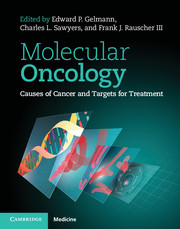Book contents
- Frontmatter
- Dedication
- Contents
- List of Contributors
- Preface
- Part 1.1 Analytical techniques: analysis of DNA
- 1 Cancer genome sequencing
- 2 Genome-wide association studies of cancer predisposition
- 3 Comparative genomic hybridization
- 4 Chromosome analysis: molecular cytogenetic approaches
- 5 DNA methylation
- Part 1.2 Analytical techniques: analysis of RNA
- Part 2.1 Molecular pathways underlying carcinogenesis: signal transduction
- Part 2.2 Molecular pathways underlying carcinogenesis: apoptosis
- Part 2.3 Molecular pathways underlying carcinogenesis: nuclear receptors
- Part 2.4 Molecular pathways underlying carcinogenesis: DNA repair
- Part 2.5 Molecular pathways underlying carcinogenesis: cell cycle
- Part 2.6 Molecular pathways underlying carcinogenesis: other pathways
- Part 3.1 Molecular pathology: carcinomas
- Part 3.2 Molecular pathology: cancers of the nervous system
- Part 3.3 Molecular pathology: cancers of the skin
- Part 3.4 Molecular pathology: endocrine cancers
- Part 3.5 Molecular pathology: adult sarcomas
- Part 3.6 Molecular pathology: lymphoma and leukemia
- Part 3.7 Molecular pathology: pediatric solid tumors
- Part 4 Pharmacologic targeting of oncogenic pathways
- Index
- References
3 - Comparative genomic hybridization
from Part 1.1 - Analytical techniques: analysis of DNA
Published online by Cambridge University Press: 05 February 2015
- Frontmatter
- Dedication
- Contents
- List of Contributors
- Preface
- Part 1.1 Analytical techniques: analysis of DNA
- 1 Cancer genome sequencing
- 2 Genome-wide association studies of cancer predisposition
- 3 Comparative genomic hybridization
- 4 Chromosome analysis: molecular cytogenetic approaches
- 5 DNA methylation
- Part 1.2 Analytical techniques: analysis of RNA
- Part 2.1 Molecular pathways underlying carcinogenesis: signal transduction
- Part 2.2 Molecular pathways underlying carcinogenesis: apoptosis
- Part 2.3 Molecular pathways underlying carcinogenesis: nuclear receptors
- Part 2.4 Molecular pathways underlying carcinogenesis: DNA repair
- Part 2.5 Molecular pathways underlying carcinogenesis: cell cycle
- Part 2.6 Molecular pathways underlying carcinogenesis: other pathways
- Part 3.1 Molecular pathology: carcinomas
- Part 3.2 Molecular pathology: cancers of the nervous system
- Part 3.3 Molecular pathology: cancers of the skin
- Part 3.4 Molecular pathology: endocrine cancers
- Part 3.5 Molecular pathology: adult sarcomas
- Part 3.6 Molecular pathology: lymphoma and leukemia
- Part 3.7 Molecular pathology: pediatric solid tumors
- Part 4 Pharmacologic targeting of oncogenic pathways
- Index
- References
Summary
Cells progress to cancer by the acquisition of genetic and epigenetic alterations that promote growth and survival. The genomic alterations range from mutations in individual nucleotides to rearrangements and changes in the copy number of chromosomal segments or whole chromosomes. The former result in point mutations that inactivate tumor suppressor genes or activate oncogenes, and the latter produce novel fusion genes and/or alter the expression of one or more genes that may individually or co-operatively modify cell behavior.
The technique of comparative genomic hybridization (CGH) was first introduced in 1992 as a means to assess copy number changes in genomes (1). In the original implementation of CGH, a test genomic DNA, such as DNA extracted from a tumor, and a reference DNA, typically genomic DNA from normal cells, were differentially labeled and then hybridized to normal metaphase chromosomes. The chromosomes provided a readily available physical map of the genome. For mammalian genomes it is important to suppress the hybridization of the large number of repetitive sequences. This is typically done by including an excess of unlabeled repetitive DNA (Cot-1 DNA) in the hybridization reaction. Measurement of the relative intensities of the hybridization of the test and reference genomes along the metaphase chromosomes provides a profile of the relative copy number of sequences in the test and reference genomes. Chromosome CGH provided genomic resolution on the order of 10 Mb. Starting in the late 1990s, the physical map provided by metaphase chromosomes was superseded by arrays of mapped genomic clones (2,3), cDNAs, and more recently oligonucleotides, and the technique became known as “array CGH” to distinguish it from CGH using metaphase chromosomes (Figure 3.1).
- Type
- Chapter
- Information
- Molecular OncologyCauses of Cancer and Targets for Treatment, pp. 21 - 27Publisher: Cambridge University PressPrint publication year: 2013

